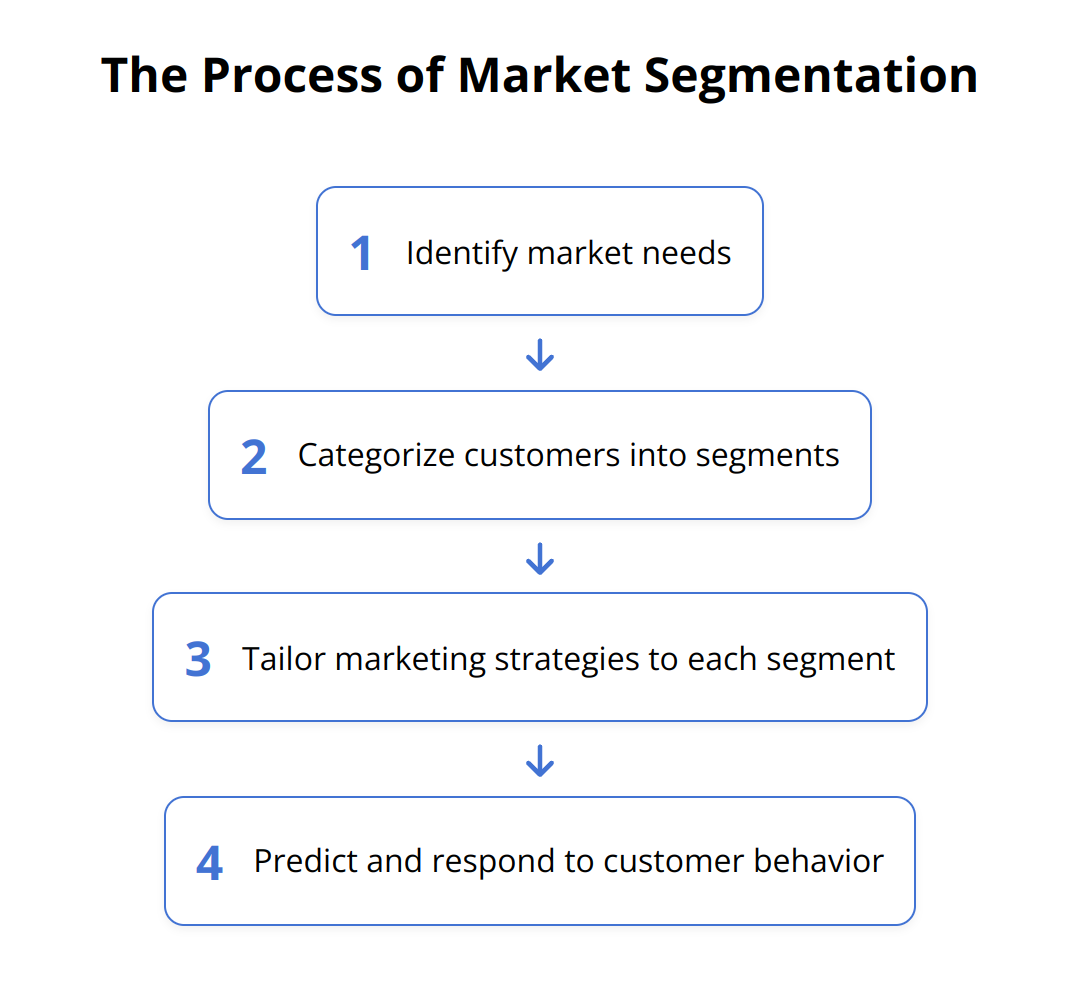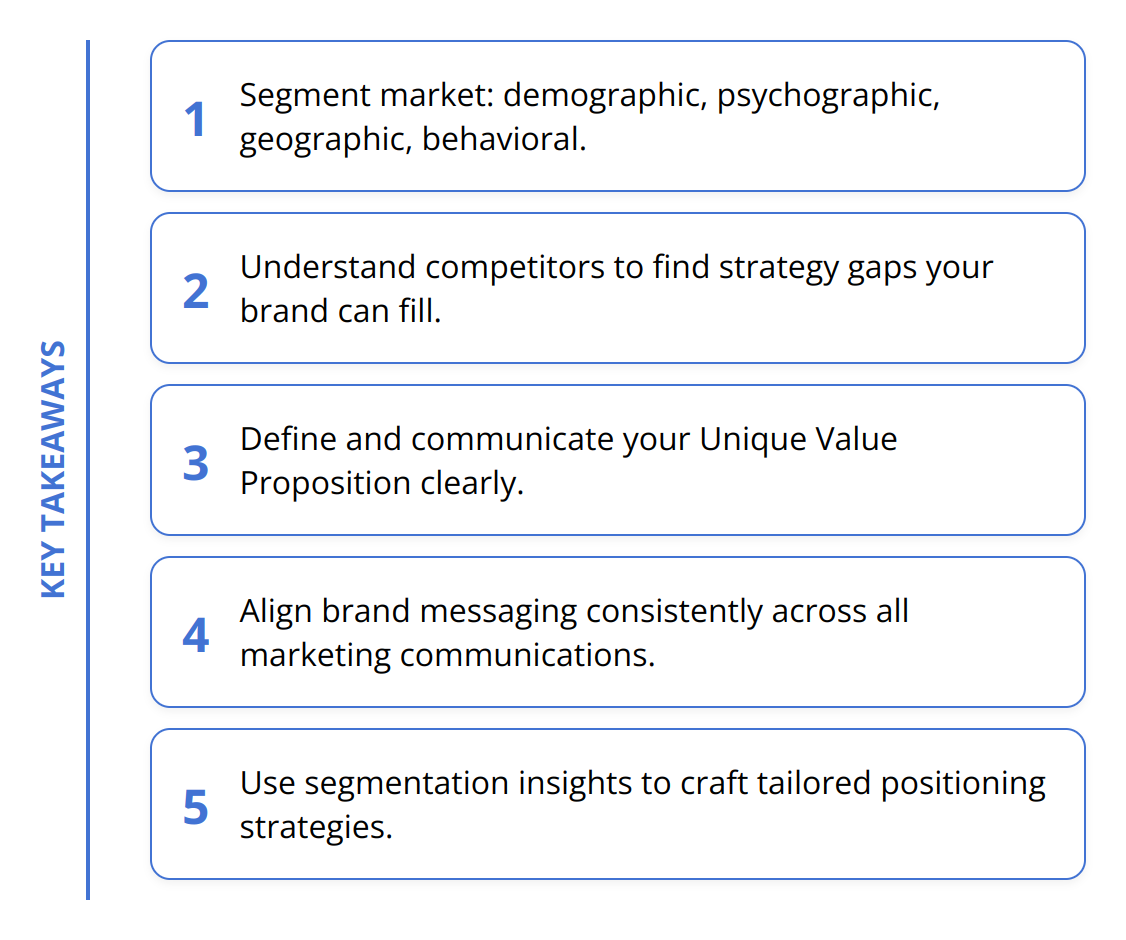Understanding the landscape of marketing can often feel like navigating through a complex maze. We at Emplibot believe breaking down concepts like market segmentation and positioning can simplify this journey. These terms are foundational to crafting a marketing strategy that speaks directly to your target audience. This post aims to clarify their meanings, roles, and how they work together to enhance your marketing efforts.
Contents
ToggleUnderstanding Market Segmentation
Market segmentation is not just a step in your marketing strategy; it’s the backbone that ensures your message hits the mark. It’s about diving deep into who your audience is, beyond surface-level characteristics. Let’s decode how segmentation can turbocharge your marketing efforts by breaking it down into more manageable parts.
The Essence of Market Segmentation
At its core, market segmentation is the process of dividing a broad consumer or business market, normally consisting of existing and potential customers, into sub-groups of consumers (known as segments) based on some type of shared characteristic. It’s vital for marketers to understand that not all customers are the same. Different individuals have varying needs, wants, and pain points. Recognizing these differences and categorizing customers accordingly is what market segmentation is all about. This process not just amplifies the efficacy of your marketing efforts but substantially increases the chances of converting leads into loyal customers.

Why Market Segmentation Matters
Ignoring market segmentation is akin to speaking into a void. You might be putting out messages, but without segmentation, it’s hit or miss whether they reach the right ears. Market segmentation allows you to tailor your messaging and product offerings to the specific needs, behaviors, and interests of different groups. This tailored approach drastically improves the efficiency of your marketing activities, ensuring that the right message gets to the right people at the right time. It ultimately leads to a more personalized customer experience, and in today’s market, personalization isn’t just appreciated; it’s expected.
The Four Pillars of Market Segmentation
Market segmentation can be dissected into four primary types: demographic, psychographic, geographic, and behavioral.
-
Demographic segmentation slices the market by attributes like age, gender, income, education, and occupation. This type is foundational because it’s straightforward and often directly correlates with consumer needs and wants.
-
Psychographic segmentation delves into the psychological attributes of customers, such as their lifestyle, values, attitudes, and interests. Understanding these deeper, often emotional triggers can lead to highly compelling marketing strategies.
-
Geographic segmentation divides the market based on location. Simple yet powerfully relevant, this type capitalizes on the premise that people’s needs vary by their locale – what works in a bustling city might not resonate in a rural setting.
-
Behavioral segmentation is centered on purchasing behavior, including usage rate, brand interactions, purchase history, and response to previous marketing efforts. By understanding patterns in behavior, marketers can predict future actions and tailor their strategies accordingly.

Each type of segmentation offers a lens through which to view your target audience, providing insights that can shape not only your marketing strategies but also product development, pricing, and distribution channels.
For deeper insights into the application and advantages of market segmentation, check out our posts on top market segmentation strategies and the importance of customer segmentation.
By mastering market segmentation, you’re not just shouting into the void. You’re making strategic decisions on where to focus your efforts and resources to not only meet but exceed customer expectations, ensuring your brand not only survives but thrives in a crowded marketplace.
What is Positioning in Marketing?
Positioning in marketing is about setting your brand apart in the crowded marketplace. It’s how you ensure your product or service occupies a distinct and valued place in your target customers’ minds. Unlike market segmentation, which categorizes the consumer base, positioning focuses on the brand’s identity and its relation to the competitors and the market. The ultimate goal is to make your brand synonymous with a specific need or value in the eyes of the consumer.
Creating a Distinct Brand Identity Through Positioning
Positioning is instrumental in crafting a brand identity that resonates with your target audience. It’s about carefully molding perceptions and associations related to your brand. Effective positioning communicates the benefits and uniqueness of your product or service, making it the preferred choice among alternatives. In a world where consumers are bombarded with choices, a well-positioned brand stands out, and here’s why:
When consumers identify a brand as the best solution to their specific problem or need, loyalty and trust start to build. This emotional connection is the bedrock of a strong brand identity. A clearly defined position makes your brand more memorable and can significantly affect purchasing decisions.
Leveraging Successful Positioning Strategies
The best brand positioning strategies are those that connect with consumers on an emotional level. Consider Apple’s focus on innovation and design, or Nike’s association with achievement and inspiration. These brands have mastered the art of positioning by not just selling products but by selling dreams, aspirations, and a particular lifestyle.
For actionable insights, marketers should study these strategies carefully. Observing how successful brands position themselves can reveal much about consumer desires and how to meet them effectively. For more on this, explore our insights on marketing strategy integration.

Practical Tips for Effective Positioning
To successfully position your brand, consider the following practical steps:
-
Understand Your Competitors: Analyze what they are doing right and wrong. Find gaps in their strategy that your brand can fill.
-
Define Your Unique Value Proposition (UVP): Your UVP is what makes your product or service special. It should be clear, concise, and compelling.
-
Communicate Consistently: Every piece of content, every marketing campaign, even your product design should reflect your positioning.
-
Listen to Your Customers: Their feedback can provide invaluable insights into how your brand is perceived and how you can improve your positioning strategy.
Brands that excel in positioning understand that it’s not just about being different, but about being meaningfully different in a way that matters to customers. This meaningful difference ensures that your brand can not only attract but also retain a dedicated customer base in a competitive market landscape.

By focusing on these key areas, your brand can create a positioning strategy that resonates deeply with your target audience, setting the stage for sustained success and market leadership.
Bridging Segmentation and Positioning
The journey from recognizing who your customers are to how your brand is perceived in the marketplace embodies the essence of marketing strategy. Segmentation and positioning, though distinct in their objectives and applications, when woven together, create a profound impact on your marketing efficacy. This chapter explores the synergy between these concepts and outlines a strategic approach for their joint application.
Distinct Yet Interdependent
At first glance, market segmentation and positioning might seem like separate entities. Segmentation focuses on identifying customer groups based on shared characteristics, while positioning is about differentiating your brand in the consumer’s mind. However, their separation is superficial at best. The truth lies in how these strategies are deeply interconnected and mutually reinforcing.
Segmentation lays the groundwork by providing detailed insights into your audience, allowing for targeted marketing efforts. It ensures that your marketing resources are channeled effectively to the groups most likely to convert. Positioning, on the other hand, capitalizes on this foundation by aligning your brand’s strengths and unique attributes with the identified segments’ needs and preferences.
Complementary Forces
The power of combining segmentation with positioning cannot be overstated. Here’s why:
-
Precision in targeting: By understanding different market segments, you can craft positioning strategies that speak directly to the specific needs, desires, and challenges of each group.
-
Increased relevance: Tailored positioning ensures your messaging resonates more deeply with your audience, enhancing engagement and loyalty.
-
Competitive distinction: Identifying unique segments allows for positioning that not only differentiates your brand from competitors but does so in a way that is highly relevant to each segment.
A practical application of this synergy is seen in how companies like Apple identify tech-savvy, design-appreciating segments and position their products as the epitome of innovation and aesthetics.
Maximizing Impact
For maximum impact, consider the following strategic approach:
-
Segment wisely: Use data-driven insights to identify the most profitable and reachable segments. Prioritize segments where your brand can offer unique value.
-
Craft compelling positions: Develop clear, distinct positioning statements for each selected segment that highlight the unique benefits and solutions your brand offers.
-
Align strategies and messages: Ensure your marketing strategies and communications consistently reflect the chosen positioning for each segment.
-
Monitor and adapt: Continuously analyze market responses and adjust your segmentation and positioning strategies to stay ahead of evolving customer needs and competitive landscapes.
To dive deeper into creating compelling positioning strategies, check our insights on optimizing content strategy.
In Summary
Effectively merging segmentation and positioning is not just about aligning two strategies; it’s about creating a unified marketing approach that amplifies your brand’s appeal and market reach. By understanding the unique characteristics and needs of different customer groups, and tailoring your brand’s positioning to meet those needs, you pave the way for deeper connection, enhanced loyalty, and ultimately, business growth.

Wrapping Up
Navigating the complexities of market segmentation and positioning can significantly amplify your marketing strategy’s impact. These mechanisms are not just academic concepts but practical tools that enable businesses to connect with their audience more effectively. Market segmentation breaks down the vast expanse of your target market into manageable groups, ensuring that your marketing efforts are focused and efficient. Positioning, then, takes these efforts a step further by carving out a distinctive space for your brand in the consumer’s mind.

The strategic importance of both segmentation and positioning in marketing cannot be overstated. They work in tandem to enhance the relevance of your marketing messages and ensure they resonate with the intended audience. By applying these practices thoughtfully, businesses can achieve:
-
Clearer customer insights
-
Higher marketing effectiveness
-
Stronger brand identity
-
Deeper customer loyalty
For marketers and business owners aiming for enduring success, embracing a balanced approach between market segmentation and positioning is indispensable. It’s about finding the sweet spot where your brand’s value proposition meets customer needs in a way that is both unique and incisive.
As you fine-tune your marketing strategies, remember that tools and technologies are available to streamline and enrich your efforts. At Emplibot, we understand the value of content in engaging and converting your target audience. With our solution, publishing SEO-friendly articles to your WordPress site becomes effortless and automatic, covering everything from keyword research to internal linking. Learn more about how we can help enhance your content strategy at Emplibot.
In conclusion, the power of market segmentation and positioning lies in their ability to guide targeted, impactful marketing strategies. By judiciously employing these practices, brands can navigate the competitive market landscape with precision and creativity, building a solid foundation for growth and profitability.











